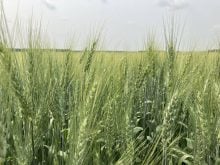A deadly wheat pathogen continues to mutate and expand its sphere of influence but at a slower pace than scientists first expected.Ug99, a virulent strain of stem rust first discovered in Uganda in 1999, has shown up in South Africa, pushing the disease almost as far into the southern hemisphere as it has reached in the northern hemisphere.One of the big concerns with the latest migration of the fungus is that there is a historical precedent of disease spores travelling on winds to Western Australia from South Africa.“That might give the Australians a little bit more to worry about,” said Tom Fetch, stem rust pathologist with Agriculture Canada.The new strain is also able to overcome the resistance gene Sr31.“It’s a pretty major gene used in a lot of (breeding) programs,” said Fetch.Scientists believe it is only a matter of time before Ug99 appears in North America.Canada’s crop researchers have identified two lines of wheat, AC Cadillac and Peace, which have demonstrated “very good” resistance to Ug99 and its relatives in field trials conducted in Kenya.“We could probably switch over to those (lines) fairly quickly if we need to,” said Fetch.He feels Canada has a good jump on the fungus.“We’re not trying to chase it. Hopefully we’re staying ahead of it,” he said.Ug99 was the first strain of stem rust to overcome resistance genes that protected the world’s wheat crops for more than four decades. With its mutated offspring, there are now four strains of the disease that have overcome four different resistance genes.Stem rust is the most feared of the three types because it causes plants to topple, leading to widespread damage and potential famine.Ronnie Coffman, principal investigator for the Durable Rust Resistance in Wheat program, said 247 million acres of wheat from Morocco to Russia are at risk if the disease makes the jump to Asia from the Middle East.“That is serious wheat through there,” he said.If the disease takes hold, it could become a major market mover. Reports of the disease appearing in Asia could lead to hoarding of wheat supplies and rampant investor speculation.“You add on the psychological impact with the real impact and you could have a pretty good spike in commodity prices, I would say,” said Coffman.The last major stem rust epidemic destroyed 40 percent of the spring wheat crop in key North American production regions in the early 1950s.Today’s farmers have access to chemicals that can combat the disease but growers in many Third World countries can’t afford fungicides.“For those people particularly, we need to get resistant cultivars out quickly,” said Fetch.Ug99 initially spread into Kenya, Ethiopia and Sudan. Researchers were surprised when it was carried across the Red Sea into Yemen in 2006 on cyclone winds and Iran the following year.They were worried the fungus would use Iran as a springboard into major wheat producing regions like Pakistan and India.But nothing happened in 2008, likely due to dry conditions in Iran.“Will it go up towards Turkey or will it go towards Pakistan or will it go up to Russia? We’re all kind of waiting,” he said.
Read Also

Gap in emission regulations hamstrings Canadian hybrid truck manufacturer
A B.C. company building hybrid engines for heavy trucks says they have the opportunity to build something leading edge in Canada, but our own laws are stopping them from doing it.















